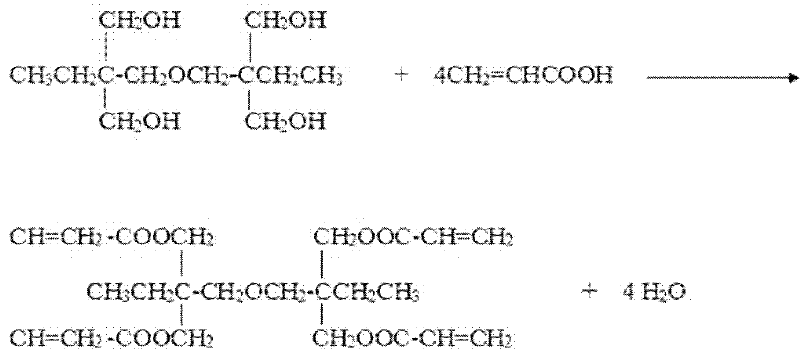Cleaning production method for di-trimethylolpropane tetra-acrylic ester or pentaerythritol tetra-acrylic ester
A technology of bis-trimethylolpropane tetraacrylate and pentaerythritol tetraacrylate is applied in the field of photocurable materials, can solve the problems of water environment pollution, high manufacturing cost, difficult treatment and the like, and achieves high yield and excellent environmental benefits. Effect
- Summary
- Abstract
- Description
- Claims
- Application Information
AI Technical Summary
Problems solved by technology
Method used
Image
Examples
Embodiment 1
[0039]Put 500 kg of toluene, 290 kg of cyclohexane, 452.57 kg of ditrimethylolpropane, 547.43 kg of acrylic acid, 8 kg of p-hydroxyanisole, 4 kg of hypophosphorous acid, and 55 kg of p-toluenesulfonic acid into the 3000L reactor; Stir, continuously feed compressed air into the kettle through the distributor at the bottom of the kettle, heat up to 85-95°C and start reflux dehydration, esterification reaction for 9-10 hours, kettle temperature 95-105°C, when reflux dehydration until no water comes out, Detect the acid value of 25-45mgKOH / g, after the reaction is over, cool to 40°C; add 25 kg of caustic soda and 60 kg of water, and stir for 30 minutes; add 6 kg of magnesium polysilicate, stir and absorb for 30 minutes; Above MPa, water and solvent are distilled under reduced pressure at 50-95°C. After the recovered water and solvent are separated, the water can be used directly in the next neutralization without any treatment, and the solvent can be used directly in the next ester...
Embodiment 2
[0041] Put 585 kilograms of cyclohexane into the 3000L reactor, 441.52 kilograms of pentaerythritol, 1028.48 kilograms of acrylic acid, 6 kilograms of p-hydroxyanisole, 3 kilograms of sodium hypophosphite, and 30 kilograms of methanesulfonic acid; Continuously feed compressed air inside, raise the temperature to 80-85°C and start reflux dehydration. The esterification reaction takes 10-12 hours. After the reaction is over, cool to 40°C; add 32 kg of caustic soda and 75 kg of water, and stir for 30 minutes; add 6.5 kg of magnesium polysilicate, stir and absorb for 30 minutes; Distill water and solvent; after the recovered water and solvent are separated, the water can be used directly in the next neutralization without any treatment, and the solvent can be used directly in the next esterification reaction; after the distillation is completed, press filter; add 60 One kilogram of alkaline calcium-based bentonite and 25 kilograms of calcium oxide were stirred for 30 minutes, and ...
Embodiment 3
[0043] 162 kilograms of methylcyclopentane, 198 kilograms of toluene, 775 kilograms of ditrimethylolpropane, 960 kilograms of acrylic acid, 7.2 kilograms of p-hydroxyanisole, 1.8 kilograms of hypophosphorous acid, and 25.6 kilograms of methanesulfonic acid were put into the 3000L reactor; Turn on the stirring, continuously feed compressed air into the kettle through the distributor at the bottom of the kettle, raise the temperature to 85-95°C and start reflux dehydration, the esterification reaction is 9-10 hours, the kettle temperature is 95-105°C, when the reflux dehydration until no water comes out , the detection acid value is 25-45mgKOH / g, after the reaction is over, cool to 40°C; add 43 kg of caustic soda and 108 kg of water, and stir for 30 minutes; add 17.3 kg of magnesium polysilicate, stir and absorb for 30 minutes; Above 0.098MPa, water and solvent are distilled under reduced pressure at 50-95°C. After the recovered water and solvent are separated, the water can be u...
PUM
 Login to View More
Login to View More Abstract
Description
Claims
Application Information
 Login to View More
Login to View More - R&D
- Intellectual Property
- Life Sciences
- Materials
- Tech Scout
- Unparalleled Data Quality
- Higher Quality Content
- 60% Fewer Hallucinations
Browse by: Latest US Patents, China's latest patents, Technical Efficacy Thesaurus, Application Domain, Technology Topic, Popular Technical Reports.
© 2025 PatSnap. All rights reserved.Legal|Privacy policy|Modern Slavery Act Transparency Statement|Sitemap|About US| Contact US: help@patsnap.com


